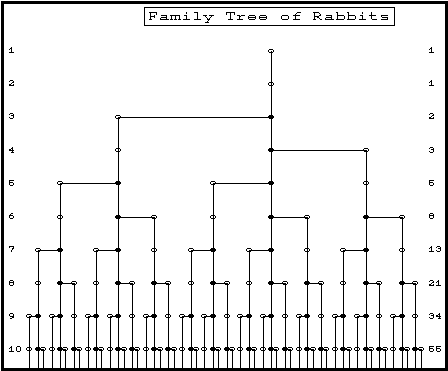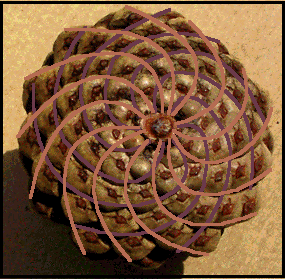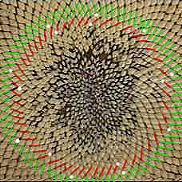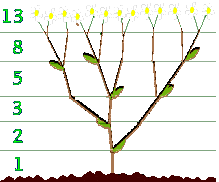
| Fibonacci Series Miss Preety Tailor |
 |
|||||||||
|
|
||||||||||
|
|
Suppose
a newborn pair of rabbits, one male and one female, is
put in the wild. The rabbits mate at the age of one
month and at the end of its second month a female can
produce another pair of rabbits. Suppose that the
rabbits never die and that each female always produces
one new pair, with one male and one female, every
month from the second month on. How many pairs
will there be in one year? |
This can be
represented in the following 'family tree' of rabbits:

The
column of numbers on the left shows the 'month', the column on
the right shows the number of pairs of rabbits in that
corresponding month.
He found that
the number in each generation was always the sum of the number
in the previous two generations. Hence, the series begins: 1,
1, 3, 5, 8, 13, 21, 34, 55, 89 ....
This series is
known as Fibonacci series.
nth
term of the series is given by
Fn
= Fn-1 + Fn-2
Fibonacci Series In Nature
Fibonacci
numbers appear every where in nature. The pattern by which
seeds are arranged on a seed head is the same as that by which
leaves are arranged around a stem, or petals around a flower.
For
example, new cells are created only at the very tip (meristem)
of a growing plant. They are formed in a spiral. This process
of growth carries through all aspects of a plant's structure:
Fibonacci
numbers
|
Fibonacci
numbers
|
|
|
|
|
|
Here
a sunflower seed illustrates this principal as the
number of clockwise spirals is 55 (marked in red, with
every tenth one in white) and the number of
counterclockwise spirals is 89 (marked in green, with
every tenth one in white.) |
Here
a plant illustrates that each successive level of
branches is often based on a progression through the
Fibonacci series. |
Why nature
follows Fibonacci series?
This is no
mere coincidence - it is 'natures way' of optimizing
structures. Rotating by phi guarantees equal spacing of leaves
and seeds no matter how far from the central starting point
you
 go.
go.
The above
picture, showing the centre of a cone flower, illustrates that
fact: notice how by one set rule the seeds are placed such
that they are neither overcrowded in the middle nor sparse
around the edges.
1. Leaves on
stream are arranged in Fibonacci series so that it gets
maximum possible exposure to light on each leaf.
2. Arranging
them using Fibonacci series
the potential problem of the upper leaves overshadowing
the lower ones, and also leaves the largest possible surface
area open to catch rain water and direct it down the stem to
the roots.
Take for example a pine cone. On examination it appears to be
made up of patterns of spirals going in both directions. This
is emphasized in colour. Interestingly, there are 13
anti-clockwise spirals (the pink ones) and 8 clockwise (in
purple). This turns out to always be the case: the number of
spirals going in both directions are consecutive terms in the
Fibonacci series. This is just one example in which the
numbers appear, and applies (though not always so visibly) to
all natural growth. It is clearly evident, for example, in the
picture of the coneflower at the top of this page.



